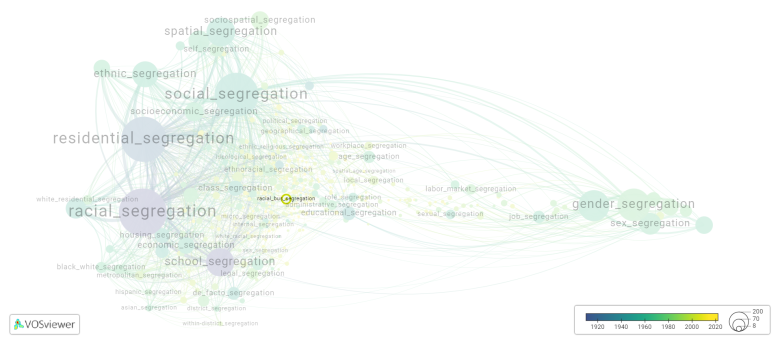Racial bus segregation: Difference between revisions
(Creating page) |
(Creating page) |
||
| Line 16: | Line 16: | ||
While racial bus segregation is no longer legally practiced in the United States, it remains an important part of American history and serves as a reminder of the struggles faced by African Americans during the era of Jim Crow and the fight for civil rights. | While racial bus segregation is no longer legally practiced in the United States, it remains an important part of American history and serves as a reminder of the struggles faced by African Americans during the era of Jim Crow and the fight for civil rights. | ||
==See also== | ==See also== | ||
==Related segregation forms== | |||
Racial bus segregation is frequently discussed in the literature with the following segregation forms: | |||
[[racial segregation]] | |||
[[File:racial_bus_segregation.png|780x780px]] | |||
For the complete network of associated segregation forms, see: | |||
year of publication https://tinyurl.com/2235lkhw | |||
Louvain clusters https://tinyurl.com/2d8wg5n3 | |||
betweenness centrality https://tinyurl.com/223udk5r | |||
disciplines where segregation forms first appeared https://tinyurl.com/244d8unz | |||
==References== | ==References== | ||
==Notes== | ==Notes== | ||
Revision as of 14:38, 27 September 2024
Date and country of first publication[1]
2013
United States
Definition
Racial bus segregation refers to the practice of segregating individuals based on their race or ethnicity on public buses. This practice was most prominent in the United States during the period of Jim Crow laws, which enforced racial segregation in many aspects of life, including transportation.
In the late 19th and early 20th centuries, many states in the American South enacted laws called "Black Codes" or "Jim Crow" laws, which mandated racial segregation. These laws required separate facilities and accommodations for Black and White people, including separate seating areas on public transportation.
During this time, African Americans were often required to sit in the back of the bus or in designated "colored" sections, while White people sat in the front or in the "White" sections. In some cities, there were even separate buses for Black and White passengers. This segregation on buses was enforced by both legislation and social customs, and anyone found violating the segregation rules could face legal consequences.
The most well-known instance of racial bus segregation is the Montgomery Bus Boycott that took place in Montgomery, Alabama, in 1955-1956. This boycott was sparked by the arrest of Rosa Parks, an African American woman who refused to give up her seat to a White passenger on a Montgomery bus. The boycott lasted for over a year and eventually led to the desegregation of buses in Montgomery.
Racial bus segregation was ultimately ruled unconstitutional by the landmark Supreme Court case, Brown v. Board of Education, in 1954. This case declared the doctrine of "separate but equal" unconstitutional, stating that racially segregated public facilities, including buses, violated the Fourteenth Amendment's guarantee of equal protection under the law.
While racial bus segregation is no longer legally practiced in the United States, it remains an important part of American history and serves as a reminder of the struggles faced by African Americans during the era of Jim Crow and the fight for civil rights.
See also
Related segregation forms
Racial bus segregation is frequently discussed in the literature with the following segregation forms:
For the complete network of associated segregation forms, see:
year of publication https://tinyurl.com/2235lkhw
Louvain clusters https://tinyurl.com/2d8wg5n3
betweenness centrality https://tinyurl.com/223udk5r
disciplines where segregation forms first appeared https://tinyurl.com/244d8unz
References
Notes
- ↑ Date and country of first publication as informed by the Scopus database (December 2023).
At its current state, this definition has been generated by a Large Language Model (LLM) so far without review by an independent researcher or a member of the curating team of segregation experts that keep the Segregation Wiki online. While we strive for accuracy, we cannot guarantee its reliability, completeness and timeliness. Please use this content with caution and verify information as needed. Also, feel free to improve on the definition as you see fit, including the use of references and other informational resources. We value your input in enhancing the quality and accuracy of the definitions of segregation forms collectively offered in the Segregation Wiki ©.
Racial bus segregation appears in the following literature
Kuby C.R. (2013). Evoking emotions and unpacking layered histories through young children's illustrations of racial bus segregation. Journal of Early Childhood Literacy, 13(2), 271-300. https://doi.org/10.1177/1468798411433364

